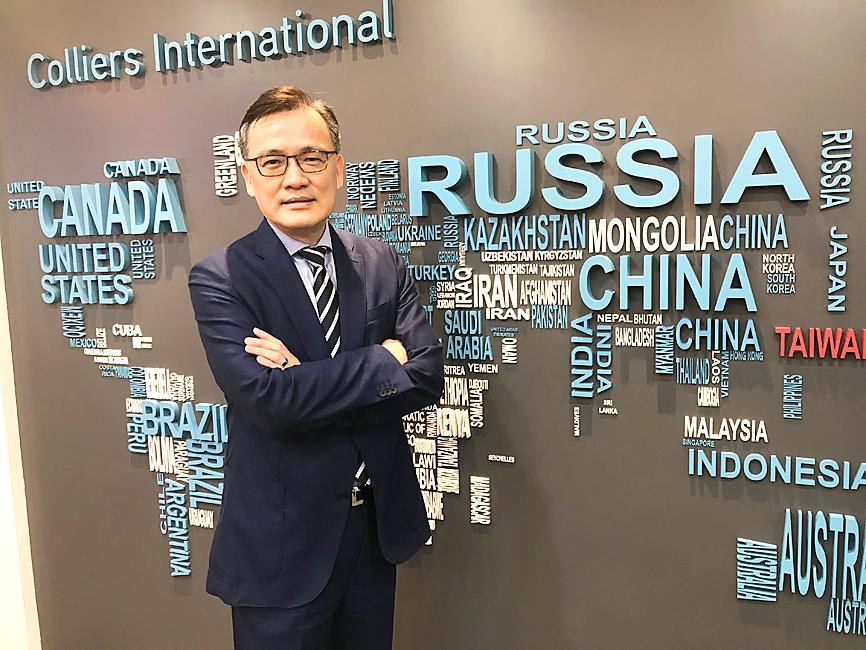Demand for warehouses and logistics facilities has spiked in the past few years, aided by booming online shopping and port congestion amid the COVID-19 pandemic, Colliers International Taiwan (高力國際) said yesterday.
The past three years have seen 22 major transactions of warehouses and logistics facilities valued at NT$29.94 billion (US$1.05 billion) and covering 209,100 ping (690,030m2), the size of 2.3 Daan Forest Parks in Taipei, the property broker said.
Colliers Taiwan managing director Andrew Liu (劉學龍) identified three investment approaches in warehouses and logistics facilities, namely by taking up the role of landlords, service providers and operators.

Photo: Hsu Yi-ping, Taipei Times
Cathay Life Insurance Co (國泰人壽) and Chunghwa Post Co (中華郵政) are landlords to several warehouses and logistics facilities that generate rental incomes equal to 4 percent of annual returns, Liu said.
Ally Logistic Property Co (永聯物流) offers warehousing and logistics solutions for clients in electronics and retail sectors, a business model that provides higher returns than rents, Liu said.
Meanwhile, companies such as food and beverage conglomerate Uni-President Enterprises Corp (統一企業), supermarket chain operator PX Mart Co Ltd (全聯實業) and e-commerce operator Momo.com Inc (富邦媒體) buy plots and build their own warehouses and logistics facilities to meet operational needs, Liu said, adding that their business scales are large and their pockets deep enough to warrant such a strategy.
Most warehousing deals are concentrated in Taoyuan’s Guanyin (觀音), Gueishan (龜山), Dasi (大溪) and Lujhu (蘆竹) districts; New Taipei City’s Wugu District (五股); Keelung; and Hsinchu’s Hukou Township (湖口), Collier Taiwan said.
Solid demand has pushed up industrial plot prices by 40 percent since 2018, the broker said.
Warehouses and logistics facilities are sparse in Taichung, Tainan and Kaohsiung, as well as Changhua County, but their numbers might increase in central and southern Taiwan in the coming years on the back of emerging industrial clusters and land scarcity in the north, Collier Taiwan said.
Industrial plots of more than 10,000 ping and near highway entrances are ideal sites for warehouses and logistics facilities, it said.
Apart from Cathay Life, Nan Shan Life Insurance Co (南山人壽) and Transglobe Life Insurance Co (全球人壽) also have displayed investment interest in warehouses and logistics facilities, it said.

CHIP RACE: Three years of overbroad export controls drove foreign competitors to pursue their own AI chips, and ‘cost US taxpayers billions of dollars,’ Nvidia said China has figured out the US strategy for allowing it to buy Nvidia Corp’s H200s and is rejecting the artificial intelligence (AI) chip in favor of domestically developed semiconductors, White House AI adviser David Sacks said, citing news reports. US President Donald Trump on Monday said that he would allow shipments of Nvidia’s H200 chips to China, part of an administration effort backed by Sacks to challenge Chinese tech champions such as Huawei Technologies Co (華為) by bringing US competition to their home market. On Friday, Sacks signaled that he was uncertain about whether that approach would work. “They’re rejecting our chips,” Sacks

NATIONAL SECURITY: Intel’s testing of ACM tools despite US government control ‘highlights egregious gaps in US technology protection policies,’ a former official said Chipmaker Intel Corp has tested chipmaking tools this year from a toolmaker with deep roots in China and two overseas units that were targeted by US sanctions, according to two sources with direct knowledge of the matter. Intel, which fended off calls for its CEO’s resignation from US President Donald Trump in August over his alleged ties to China, got the tools from ACM Research Inc, a Fremont, California-based producer of chipmaking equipment. Two of ACM’s units, based in Shanghai and South Korea, were among a number of firms barred last year from receiving US technology over claims they have

It is challenging to build infrastructure in much of Europe. Constrained budgets and polarized politics tend to undermine long-term projects, forcing officials to react to emergencies rather than plan for the future. Not in Austria. Today, the country is to officially open its Koralmbahn tunnel, the 5.9 billion euro (US$6.9 billion) centerpiece of a groundbreaking new railway that will eventually run from Poland’s Baltic coast to the Adriatic Sea, transforming travel within Austria and positioning the Alpine nation at the forefront of logistics in Europe. “It is Austria’s biggest socio-economic experiment in over a century,” said Eric Kirschner, an economist at Graz-based Joanneum

OPTION: Uber said it could provide higher pay for batch trips, if incentives for batching is not removed entirely, as the latter would force it to pass on the costs to consumers Uber Technologies Inc yesterday warned that proposed restrictions on batching orders and minimum wages could prompt a NT$20 delivery fee increase in Taiwan, as lower efficiency would drive up costs. Uber CEO Dara Khosrowshahi made the remarks yesterday during his visit to Taiwan. He is on a multileg trip to the region, which includes stops in South Korea and Japan. His visit coincided the release last month of the Ministry of Labor’s draft bill on the delivery sector, which aims to safeguard delivery workers’ rights and improve their welfare. The ministry set the minimum pay for local food delivery drivers at